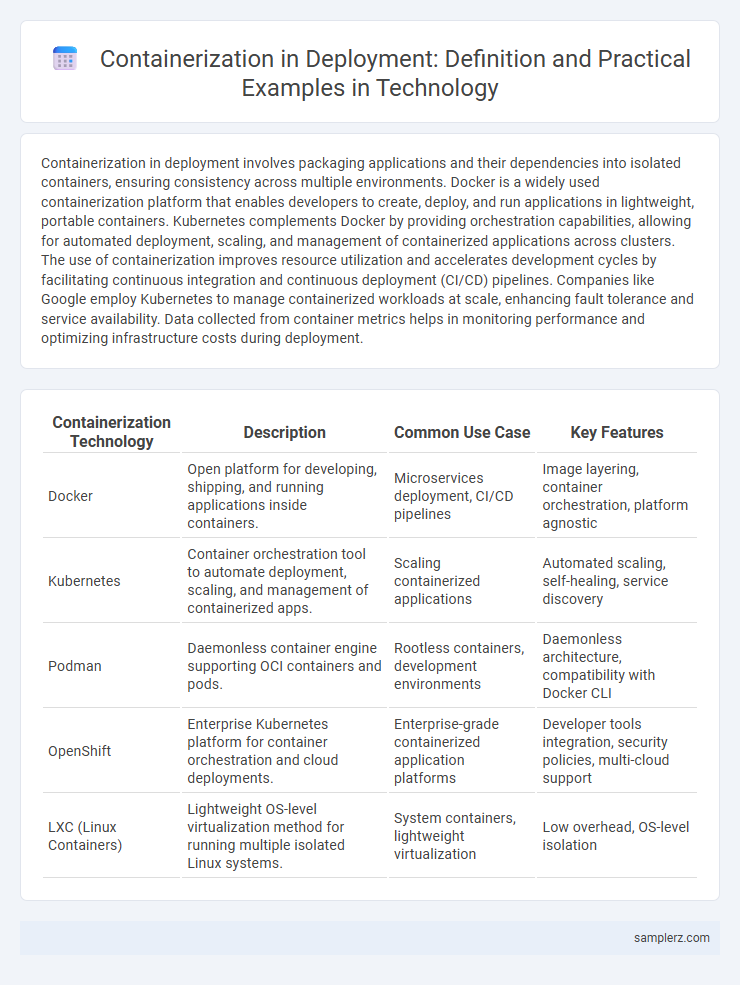Containerization in deployment involves packaging applications and their dependencies into isolated containers, ensuring consistency across multiple environments. Docker is a widely used containerization platform that enables developers to create, deploy, and run applications in lightweight, portable containers. Kubernetes complements Docker by providing orchestration capabilities, allowing for automated deployment, scaling, and management of containerized applications across clusters. The use of containerization improves resource utilization and accelerates development cycles by facilitating continuous integration and continuous deployment (CI/CD) pipelines. Companies like Google employ Kubernetes to manage containerized workloads at scale, enhancing fault tolerance and service availability. Data collected from container metrics helps in monitoring performance and optimizing infrastructure costs during deployment.
Table of Comparison
| Containerization Technology | Description | Common Use Case | Key Features |
|---|---|---|---|
| Docker | Open platform for developing, shipping, and running applications inside containers. | Microservices deployment, CI/CD pipelines | Image layering, container orchestration, platform agnostic |
| Kubernetes | Container orchestration tool to automate deployment, scaling, and management of containerized apps. | Scaling containerized applications | Automated scaling, self-healing, service discovery |
| Podman | Daemonless container engine supporting OCI containers and pods. | Rootless containers, development environments | Daemonless architecture, compatibility with Docker CLI |
| OpenShift | Enterprise Kubernetes platform for container orchestration and cloud deployments. | Enterprise-grade containerized application platforms | Developer tools integration, security policies, multi-cloud support |
| LXC (Linux Containers) | Lightweight OS-level virtualization method for running multiple isolated Linux systems. | System containers, lightweight virtualization | Low overhead, OS-level isolation |
Introduction to Containerization in Deployment
Containerization in deployment leverages lightweight, portable units called containers to encapsulate applications and their dependencies, ensuring consistency across diverse environments. Docker is a widely adopted platform that enables developers to build, ship, and run containers efficiently, streamlining the continuous integration and continuous deployment (CI/CD) pipelines. Kubernetes serves as a robust orchestration tool, managing containerized applications at scale with automated deployment, scaling, and management capabilities.
Key Advantages of Containerizing Applications
Containerizing applications significantly reduces deployment times by enabling consistent environments across development, testing, and production stages, leading to fewer compatibility issues. It enhances scalability and resource efficiency since containers share the host OS kernel while isolating application processes, allowing multiple containers to run simultaneously on a single system. Moreover, container orchestration tools like Kubernetes automate load balancing, self-healing, and service discovery, ensuring high availability and simplified management of complex microservices architectures.
Docker: The Pioneer of Deployment Containerization
Docker revolutionized deployment containerization by enabling developers to package applications with all dependencies into lightweight, portable containers that run consistently across various environments. Its container runtime leverages OS-level virtualization to isolate applications, ensuring efficient resource utilization and seamless scalability in cloud infrastructures. The widespread adoption of Docker has standardized container orchestration workflows, enhancing CI/CD pipelines and accelerating application delivery in modern DevOps practices.
Kubernetes for Orchestrating Containers
Kubernetes is a leading container orchestration platform that automates the deployment, scaling, and management of containerized applications. It uses pods to group containers and provides self-healing capabilities, service discovery, and load balancing to ensure high availability. Kubernetes supports multi-cloud environments and integrates with CI/CD pipelines to streamline continuous deployment processes.
Real-World Example: Deploying a Web App with Containers
Deploying a web application using Docker containers enables consistent environments across development, testing, and production, ensuring seamless scaling and maintenance. Kubernetes orchestration manages containerized microservices, automating deployment, load balancing, and fault tolerance for the web app. This containerized approach reduces dependencies conflicts and accelerates continuous integration and continuous deployment (CI/CD) pipelines.
Microservices Architecture Powered by Containers
Microservices architecture leverages containerization to streamline deployment by encapsulating individual services within lightweight, portable containers such as Docker. This approach enhances scalability, fault isolation, and continuous integration, allowing seamless updates without disrupting the entire application. Kubernetes orchestrates these containers, automating deployment, scaling, and management to optimize resource utilization in cloud environments.
Containerization in Continuous Integration/Continuous Deployment (CI/CD)
Containerization streamlines Continuous Integration/Continuous Deployment (CI/CD) pipelines by packaging applications and their dependencies into lightweight, portable containers, ensuring consistent environments from development to production. Docker and Kubernetes are prominent tools that enable automated build, test, and deployment stages, enhancing scalability and reducing integration errors. This approach accelerates delivery cycles and improves deployment reliability in modern DevOps workflows.
Serverless Deployments Enhanced by Containers
Serverless deployments leverage containerization to improve scalability and resource efficiency by packaging functions and dependencies into lightweight, isolated containers. Platforms like AWS Lambda and Google Cloud Run enable rapid deployment and automatic scaling of containerized serverless applications, reducing cold start latency and enhancing performance. Container orchestration tools such as Kubernetes further optimize serverless workflows by managing container lifecycles and facilitating seamless updates.
Security Practices in Containerized Deployments
Containerization enhances deployment security by isolating applications within lightweight, portable containers using platforms like Docker and Kubernetes. Implementing runtime security tools such as Aqua Security or Twistlock monitors container behavior, detects vulnerabilities, and enforces compliance policies. Employing image scanning, role-based access control (RBAC), and network segmentation further reduces the attack surface and mitigates risks in containerized environments.
Future Trends in Containerization Technologies
Kubernetes continues to dominate container orchestration by enabling scalable and automated deployment across cloud environments. Emerging innovations like serverless containers and microVMs promise enhanced resource efficiency and faster startup times. Edge computing integration with containerization facilitates low-latency applications and real-time data processing at the network's edge.

example of containerization in deployment Infographic
 samplerz.com
samplerz.com